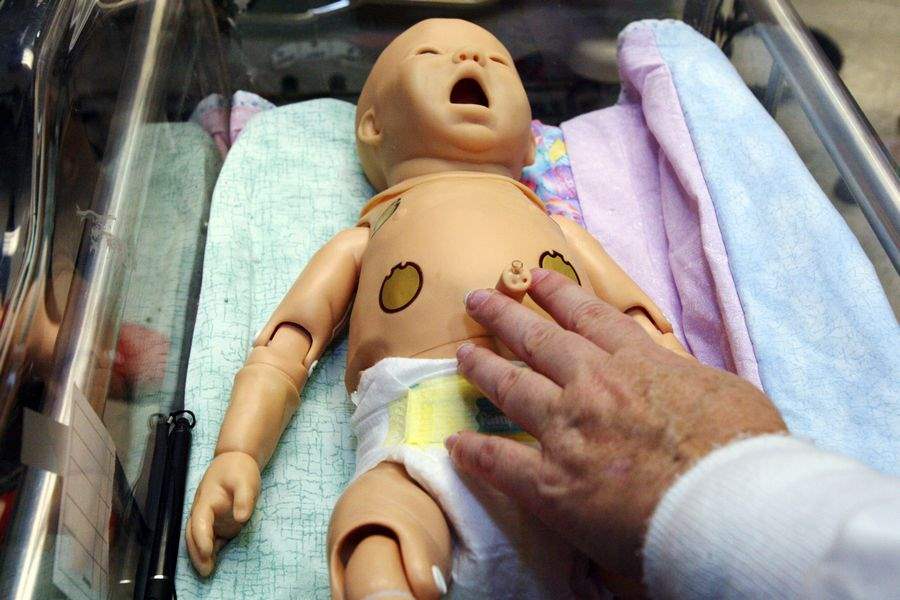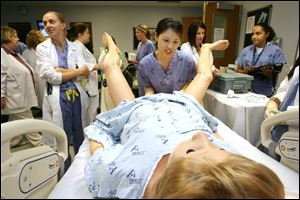
Simulated births give doctors practice
8/11/2008
Nurse Cathy Wiegand feels the heartbeat of 'baby' Hal during a simulator class at St. Vincent Mercy Medical Center.
The Blade/Amy E. Voigt
Buy This Image

Nurse Cathy Wiegand feels the heartbeat of 'baby' Hal during a simulator class at St. Vincent Mercy Medical Center.
The first indication that Alice Sanders might be a difficult patient was when the 24-year-old in labor exclaimed "don't touch me."
But after briefly and apologetically backing away from Ms. Sanders, Dr. Lina Ea returned to her pain-ridden patient. Soon Dr. Ea delivered Ms. Sanders' son, Hal, whose birth was complicated by hemorrhaging - which was controlled - and an ill-positioned shoulder.
Then the scene took an unusual turn: A high five from Dr. Pedro Roca and several cheers from others crowned Dr. Ea's ultimate delivery success at St. Vincent Mercy Medical Center in Toledo.
Ms. Sanders was silent with the newborn, because "the patient" actually is a computerized training mannequin, which can exhibit different delivery complications, make various comments to help users figure out her medical condition, and even bleed.
Hal is her simulator baby, which can be born addicted to crack or have other issues requiring treatment. Dr. Roca is associate education director of obstetrics and gynecology for Mercy Health Partners.
And Dr. Ea is a first-year obstetrical and gynecological resident who previously delivered 11 real-life babies. Still, using the life-size interactive mannequin is beneficial in gaining more experience, she said.
"It was a very good way to practice without having to worry about hurting anyone," Dr. Ea said earlier this month after her first encounter with the pregnant woman simulator.
"You work through the different scenarios, and it makes you think about what you will do in a tough situation," she added. "When you're working at the hospital, you don't always see these difficult situations."

Dr. Lina Ea, center, an intern, delivers a baby by Noelle the simulator. Dr. Ashley DeWitt, left, and Dr. Alexandra Schmidt, back right, help supervise the delivery of the doll baby.
Teaching hospitals and other facilities nationwide are adding increasingly sophisticated - and realistic - simulators to broaden their training offerings.
St. Vincent added a $45,000 pregnant woman and newborn baby simulator system in May to its Laparoscopy, Simulation & Robotics Training Center. They reside in the 2-year-old center with two other patient simulators, a man and a young child, as well as stations to practice laparoscopic surgery and other medical procedures.
Toledo Hospital also is considering acquiring one of the pregnant women simulators, known as Noelle and developed by Gaumard Scientific Co., Inc., in Miami.
Residents working at St. Vincent, as well as obstetrics nurses, other hospital employees, and University of Toledo medical students have been practicing on Noelle, which helps preserve patient safety, said Cathy Wiegand, St. Vincent training center manager.
"If they're going to make mistakes, they're going to make them here before they get to the patient," said Ms. Wiegand, adding nursing students from Mercy College of Northwest Ohio also will use the simulators.
Some complications that can be simulated with Noelle are rare but high risk, making the practice even more valuable, said Dr. Roca.
Plus, Noelle helps doctors such as himself, more experienced residents, and others perfect their teaching skills, as well as help improve communication among delivery room personnel, he said.
St. Vincent training center project manager Cristina Alvarado controls Noelle wirelessly through a laptop during practice scenarios. Ms. Alvarado can set a specific computer program for Noelle and make additions during the delivery, such as having the simulator yell out "there's something very wrong" if hemorrhaging isn't controlled or lessening bleeding if a user massages her uterus properly.
Fake blood comes from a reservoir in Noelle's right leg. Ms. Alvarado said she has come up with other ways to liven up scenarios, including simulating vomit.
"I'll get cream of mushroom soup and just put it on the side of her face," she said.
Noelle can give birth normally, breech, and by C-section, and she can exhibit symptoms of having medical conditions such as diabetes and pregnancy-related emergencies such as seizures from eclampsia. St. Vincent has two versions of the infant Hal, one that moves through Noelle's birth canal with the help of a hydraulic system and another that displays complications requiring treatment, including turning blue from lack of oxygen.
Both Noelle and Hal's blood pressure and other vital signs are monitored during training sessions too.
"She's more real than I anticipated," said Dr. Erica Takimoto, a second-year obstetrics and gynecology resident at St. Vincent. "Even though you know it's mechanized, it's probably as real to life as a computer can be."
Contact Julie M. McKinnon at:
jmckinnon@theblade.com
or 419-724-6087.